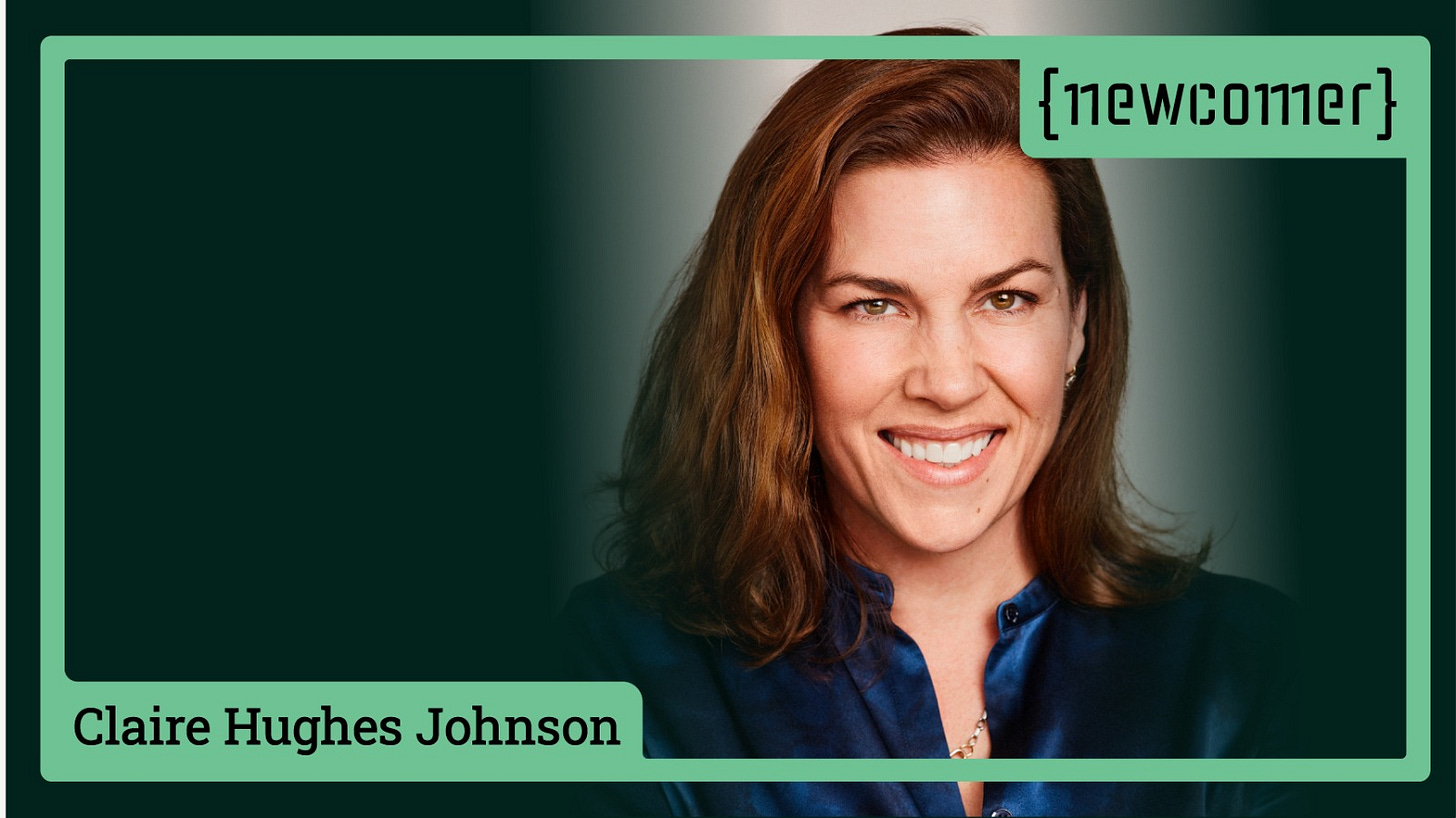Claire Hughes Johnson writes in her book, Scaling People, about a moment early on in her time at Stripe when an Irish journalist shouted to her, “You’re the lady! You’re the lady with the lads!”
Hughes Johnson, who joined Stripe in 2014 as the payments startup’s chief operating officer, works closely with two of the most iconic Silicon Valley entrepreneurs, Patrick and John Collison. During her tenure as COO, she helped bring her management know-how from Google and experience working for Sheryl Sandberg to help organize the growing company.
I invited Hughes Johnson on the Newcomer podcast to talk about her time at Stripe and the management lessons that she has put down on paper in Scaling People, which she published this year. Toward the end of our conversation, Hughes Johnson turned the tables on me and gave me some coaching.
Our conversation circles around two sections of her book, in particular. We talked about giving feedback and honesty in a corporate setting. She talked about her principle that managers should encourage people to “say the thing you cannot say.”
She writes,
How often have you sat in a meeting and mused, “It really feels like there’s something that isn’t being talked about right now”? Or had a conversation with a report and thought, “I think they’re getting upset about what I’m saying”? Or caught yourself filtering everything you say? These questions prompt a bigger one: Why don’t managers say what’s actually on their minds?
People often think that good management is about having a lot of filters, and for good reason. There’s a lot that might feel risky to say, or that feels like a personal judgment. But be wary of over-filtering. Fine-tuning your filters and pushing yourself to name your observation in a constructive way means you’ll be able to have a more honest conversation about what’s going on. Then you can all start working on a solution in earnest.
Hughes Johnson concludes scaling people with a chapter titled, “You.” It looks at how managers manage themselves.
She writes,
The more senior you become, the more creative reality gets at finding ways to beat you up every day. You will have days—sometimes many in a row—when your highest performer is threatening to quit, a top customer has just informed you that they’re moving to a competitor, you’re leading a company-wide meeting the next day and haven’t had time to prepare, and the cross-functional project you kicked off last week is already going off the rails. Many people don’t have the psychological strength and resilience to keep going. In The Hard Thing About Hard Things, Ben Horowitz calls this “the struggle,” when “nothing is easy and nothing feels right.”
To make it all work, you have to learn how to manage your time and energy. First, diagnose what gives and takes your energy. The easiest way to do this is to map out your good and bad days and track what activities add to and detract from your energy. An easy tactic is to keep check marks on your calendar of good days and bad days. After a month, look at all the good days and all the bad days, and then the good weeks and bad weeks, and see what trends jump out. When I did this exercise, I found that the weeks when I had more than one work event that kept me from having dinner with my kids and getting them to bed were bad weeks. I then resolved to restrict my work-related late nights to once a week—a personal guideline that I occasionally break, but not often. Your goal is to study what combination of time spent on which activities creates your best performance, then determine where you need to set boundaries to preserve your strongest self.
Coming up as a reporter, I was always resistant to “management” and “leadership” advice. Those words made me think of Dale Carnegie books and cash-grab leadership seminars. But as I’ve started to build Newcomer into more of a company (we’ve got a full-time chief of staff, three summer interns, and am looking to hire a full-time reporter), I’ve come around to the idea that being intentional about how you spend your time and how you work with people are essential skills, worthy of serious reflection.
These days, Hughes Johnson is a corporate officer and advisor at Stripe. She’s spending a lot of her time working with individual managers and offering coaching inside the company. So we got a taste of how Stripe’s management guru thinks.
I really enjoyed our conversation. Give it a listen.
Highlighted Excerpts
The transcript has been edited for clarity.
On Good Management.
Claire Hughes Johnson: One of the topics that came to mind during my interview with John and Patrick was the importance of good management and smart operating structures. I emphasized that we shouldn’t be reinventing the wheel. I believe in fundamentally sound management practices, rather than creating an entirely new way of thinking about performance feedback.
I paused and told them, “You guys have to be with me on this. We might start with a very basic version of performance feedback, but it’s better to do that than to let the perfect be the enemy of the good.” What’s wrong with doing everything from first principles? At some point, it becomes exhausting, and you might not be the best at constructing the system.
I also discussed the permanence of management structures and hierarchies that have been in place for hundreds of years. There have been attempts to innovate, such as holacracy, and workers’ expectations have changed. I’m not suggesting we do things the same way we did 100 years ago, but we must pay attention to history.
Patrick became particularly interested in this topic and started reading studies on management practices. He found academic research and data that showed countries with good management education and practices tend to have better economic outcomes. He agreed, saying, “Yeah, I think you’re right. Let’s put some fundamentals in place.”
Unfortunately, some young companies want to reinvent more than they should. They may have invented a great product and feel compelled to create new ways to manage people. But I believe this can be a mistake, and it’s better to rely on proven methods and structures.
Young companies, especially, should practice giving feedback.
Claire Hughes Johnson: The book has a lot of stuff on operating structures. It’s really important to have goals and metrics that everyone recognizes as the company's most important goals, and to review them publicly with everyone. The mission should be clearly articulated, along with the direction for the next three to five years. Clear feedback structures are vital. Ideally, feedback should be continuous, but in young companies, many managers are new to this process, so they’re not giving as much feedback. Therefore, you actually have to build more structures for it, which may seem counterintuitive. Some companies might say, “Oh, we’re just running after this prize, and we can’t be distracted by that.” But I respond, “Well, actually, it’s the most important thing, because you aren’t used to doing it.”
How do you think about feedback? How direct or brutal should the feedback be?
Claire Hughes Johnson: When I first started working at Google, I was shocked at how direct the engineers were, saying things like, “That’s a terrible idea.” It was not the world I had been in working in consulting or government. At first, I got defensive, but I’ve come to love it.
However, when I talk about feedback, there’s a level of directness that I don’t think is productive. If it’s so direct that it feels like an attack, people stop listening and think about survival. It becomes a matter of adapting or dying.
I have an operating principle that I talk about in the book: “Say the thing you think you cannot say.” I try to push myself and others to be open and willing to put things on the table without creating an attack response. For example, I might say to a leadership team member at Stripe, “From my seat, 10,000-20,000 feet away, I have a couple of things I’m worried about.” Then we can have an interesting conversation, looking at the problem together.
As a leader, it’s also about reading the room, even virtually. What’s the body language? Are people making eye contact? Are there weird comments in the doc? My job is to get everyone else’s opinion on the table first. Sometimes I'll say, “It feels like there's something we’re not saying. It feels tense in here.” Then I might call on someone to break through to the real thing.
There are different dynamics at play, such as power dynamics and layering issues. Sometimes you can tell the team isn’t behind their leader. Other times, there’s friction within the team or with another team. And sometimes, it's a matter of seeing the forest for the trees, stepping back to look at the bigger picture. Is this actually a good product? Why are we not seeing more user adoption? Why have we only grown 10% when the rest of the products are growing 40%? As a leader, your job is to have that bigger picture in mind and to ask, “Is this the right strategy?” Sometimes, you have to zoom out and say, “We’re having the wrong conversation, folks.”












